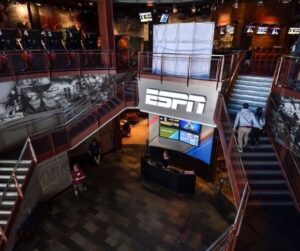For decades, the sports entertainment conglomerate ESPN has raked in the dough through Cable TV subscriptions. Even those who don’t watch sports could be, depending on their choice of programming package, paying quite a chunk to support it. But that era may soon end. Now that Disney, ESPN’s parent company, is moving toward streaming, it very well may be the death knell for Cable TV.
Love it or hate it, streaming is here to stay. As a subscriber, it’s a great way to view your favorite television series and movies without paying for all the extra channels you don’t watch. But, as Liberty Nation reported, it’s not so great for entertainers, like Marvel actress Scarlett Johansson, who filed a lawsuit against Disney when her movie, Black Widow, was released to streaming while still in theaters. Neither has it been a blessing for the Hollywood writers who have been on strike over what they claim is lost wages.
So why is ESPN considering the move toward direct-to-consumer options in a project with the codename “Flagship?” The simplest answer is money, of course. But here, too, there’s an upside and a downside for Disney’s profit margin. After reports surfaced of the plan to launch an ESPN-specific standalone streaming package, the company’s stock surged nearly 1.5% on May 18, according to Forbes. In addition, shares of Disney rose 1.30%.
Since streaming entered the game, the way people pay for their entertainment has changed. Cord-cutting, where customers cancel paid cable subscriptions and turn to cheaper or even free alternatives, has taken a chunk out of profits. For example, right now Disney collects monthly fees from the bills of cable subscribers who have access to any of the company’s networks. If your package includes ESPN, whether you watch it or not, you still pay about $9.42 per month for its inclusion in your cable bundle.

(Photo by Jeff Gritchen/Digital First Media/Orange County Register via Getty Images)
But the times they are a-changin’. “In the last quarter, 2.3 million Americans cut the cord. Currently, although the American population has increased by 80 million people since then, the number of households that pay for cable TV is down to 1990 levels,” Breitbart explained. And this has affected Disney’s pocketbook. “In the most recent quarter, income from Disney’s traditional television networks, including ESPN fell significantly to $1.8 billion, from $2.8 billion in the year-earlier quarter,” and “last year, Disney lost $4 billion on Disney+ and then lost four million subscribers.”
ESPN and the Streaming Side of Things
ESPN is not exactly new to streaming. Since 2018, customers have streamed limited MLB and NHL games on ESPN+. However, as Forbes pointed out, this channel does not give subscribers full access to ESPN or the NBA or NFL games it regularly broadcasts. Other cable networks have also sought out direct-to-consumer options, such as the NFL, which moved its Thursday Night Football from Fox Sports and the NFL network to Amazon Prime.
When will ESPN make the move to streaming? Disney CEO Bob Iger seems to think it’s inevitable, but he isn’t sure on the timeline, according to The Athletic. He said:
“We haven’t really changed our position regarding basically migrating ESPN’s flagship service as a direct-to-consumer or streaming platform. We think there’s an inevitability to that, but it’s a huge decision for us to make. And we know that we’ve got to get it right, both in terms of pricing and timing.”
Customers can already get ESPN through some streaming providers such as YouTube TV or Sling, but the packages are expensive and, like cable, you still end up paying for channels you aren’t likely to watch.
Death Knell for Cable?
So how does all this affect cable TV? ESPN is one of the most popular packages available. In fact, many sign up for cable TV just so they can get the channel to watch their favorite sports. “But now, instead of paying $180 a month for ESPN through cable TV, they will pay $30 per month to stream ESPN – which hurts Disney elsewhere,” Breitbart surmised.
ESPN, as Film rationalized, is essential for cable providers to survive, which is why it gets $9.42 from customers’ monthly cable bills while most networks get 50 cents or less. The outlet explained:
That’s a gigantic slice of the pie, and it’s also why the network is still a huge moneymaker for Disney. It’s also why Disney and CEO Bob Iger haven’t already pulled the trigger on a streaming option, as the cable money, along with contracts from major sports organizations such as the NFL and NBA provide revenue that streaming simply can’t make up for … at least not yet.”
The Athletic suggested there will be a higher monthly cost for ESPN+, significantly higher than today, when it moves to direct-to-consumer platforms. “The price point has to be larger because fewer people will be DTC subscribers versus cable.” Currently, the plan is to dive into streaming services but continue to offer ESPN through cable providers as well. For now, the money is too good to give up.
All opinions expressed are those of the author and do not necessarily represent those of Liberty Nation.
Do you have an opinion about this article? We’d love to hear it! If you send your comments to [email protected], we might even publish your edited remarks in our new feature, LN Readers Speak Out. Remember to include the title of the article along with your name, city, and state.
Please respect our republishing guidelines. Republication permission does not equal site endorsement. Click here

